Hosting the annual Art of Motion Picture Costume Design exhibition allows us to get an up-close look at costumes from recent films. This year, the exhibition featured a group of intriguing small visitors–puppets from the stop-motion animation film Coraline (2009). Like costumes created for humans, the Coraline puppets wear carefully conceived ensembles constructed from fabric and thread. But how does the design process differ when you’re working with puppets? To better understand the process of designing costumes for animated films, we talked with Deborah Cook, costume designer for Coraline. Deborah has extensive experience working on costume design for animation, including the Corpse Bride (2005), The Fantastic Mr. Fox (2009) and the UK television series The Koala Brothers. Deborah currently works as a costume designer in pre-production for Laika, the makers of Coraline. The information she provided via email interview enhanced our enjoyment and understanding of Coraline and made us look forward to her next project. Thank you Deborah, for taking the time to talk with us!
Please describe your involvement with the making of Coraline.
I was involved in the making of Coraline as the head of costume design and fabrication, seeing costumes through from their conception through colour and fabric choices, pattern cutting, animation testing and the final fitting.
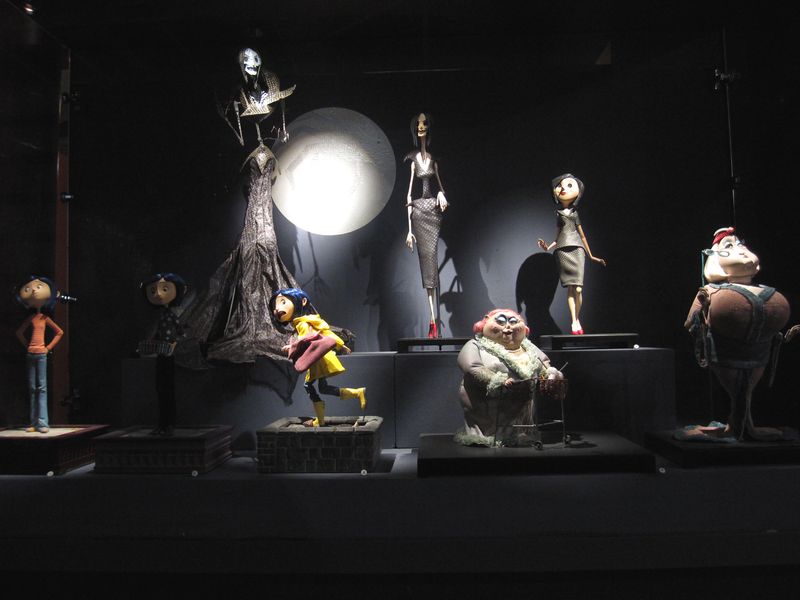 Coraline puppets on exhibition at the FIDM Museum & Galleries
Coraline puppets on exhibition at the FIDM Museum & Galleries
Is your background/training in costume design for people or do you work primarily in animation?
My background training is in fact Fine Art Sculpture with a heavy slant towards fabric and costume. I studied at Saint Martins College in London, working on installations involving sculpted textile pieces, after which I had my own art studio and worked commercially in theatre, television and film leading into stop frame animation productions and puppet costumes in particular. The differences between working with people and working with animated characters is the scale of fabric needed; the movements are pretty much within the same range. The fabric in animation is very subtle and finer and has to pass as ‘real’ within its own smaller world. People-scale fabrics look very chunky and thick and impede and mask the tiny movements and gestures the puppet characters make as well as looking very unreal and colossal on their tiny bodies. Their movements need to be reproduced akin to people and made possible within the flexibility of their costumes. To create a believable environment in miniature, the fabrics need to fit in too.
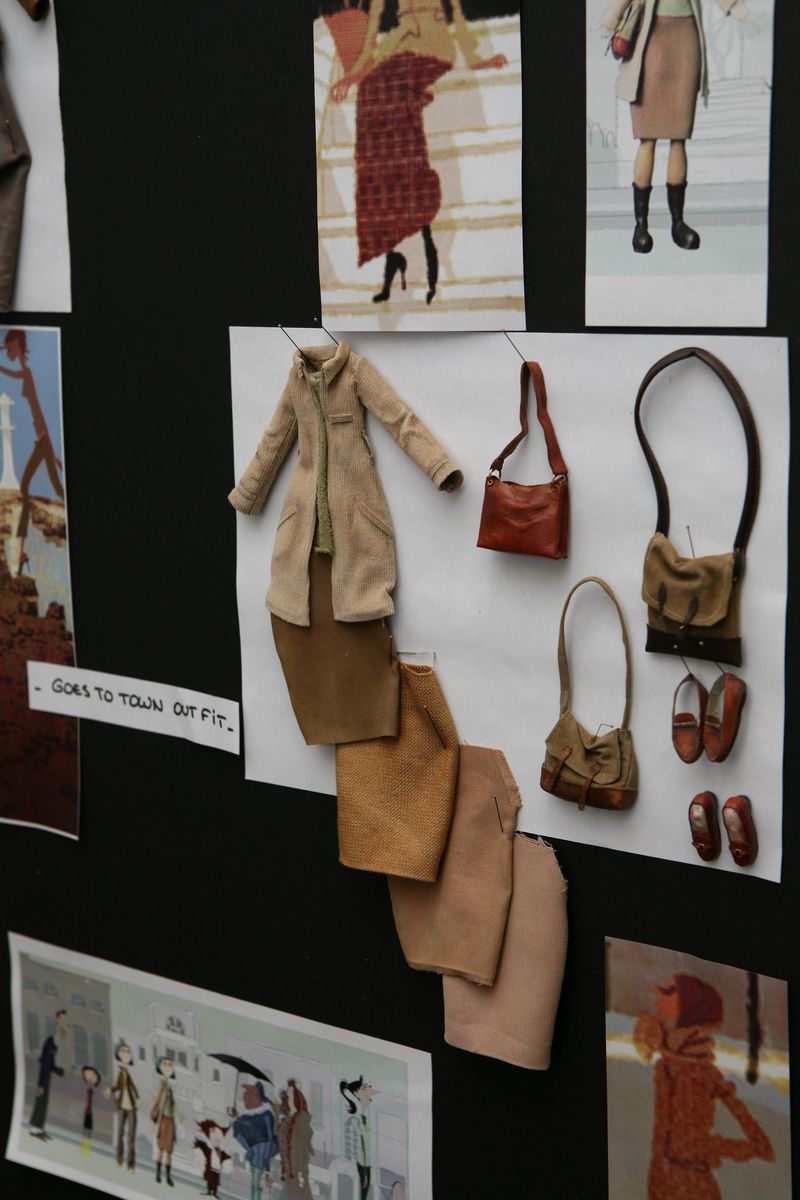 Design board for Coraline’s Mother
Design board for Coraline’s Mother
The Coraline puppets are much smaller than real people. What was the most surprising challenge or aspect of working on such a small scale?
The most surprising aspect of working in such a small scale is how much detail can actually be achieved once you’ve set out to have no limits in that respect. The most challenging aspect is finding fabrics in the scale we need and working to deadlines without losing sight of our attention to detail for the costume.
Did garments receive any special treatments (coating, etc.) before filming?
The costumes are sometimes airbrushed or even lightly sanded to ‘fade’ and ‘age’ them in certain areas so they look realistic. They’re often treated with stiffeners and fabric protector to stop them fading from the strong stage lighting or the extensive human handling. They also have a degree of internal engineering such as sculpted foam under-layers to control where the garments will crease so that each duplicate costume, of which there are many, will each crease in the same place. They’re weighted with very tiny weights to give them a natural sense of gravity and they often have different gauges of wire within their structure too, which connects to the armature to encourage the costume to move along with the characters movements in a realistic way, or to achieve an independent movement from the character, as in Coraline’s raincoat and its sleeves and Forcible’s sleeves and train of her dress. With each part of a puppet being handmade, creating duplicates is a challenge in itself.
How did you select the fabrics used in Coraline? Did you test them beforehand? If so, how?
The fabrics for Coraline were sourced from London, LA and San Francisco. We test their properties, such as how they dye and how they move and their scale against the puppets, durability etc.
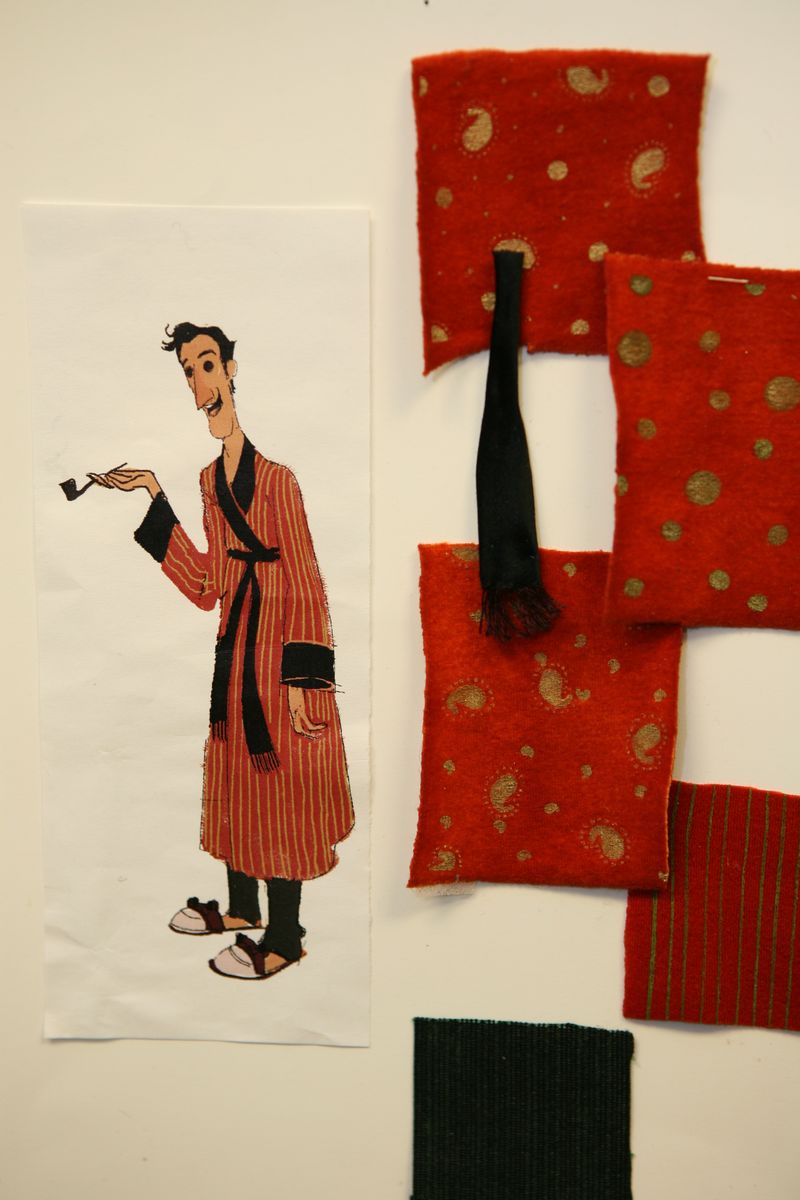 Design board for Coraline’s Other Father
Design board for Coraline’s Other Father
Did you create every item of clothing, or were you able to use purchased garments? For example, did you use any doll clothing?
No purchased garments were used at all, not even doll clothes, as they’re actually far too big and wouldn’t fit our characters or have as much attention to detail paid in their making or in their choice or scale of fabric. Barbie’s jeans, for example, are more than twice the size of Coraline’s.
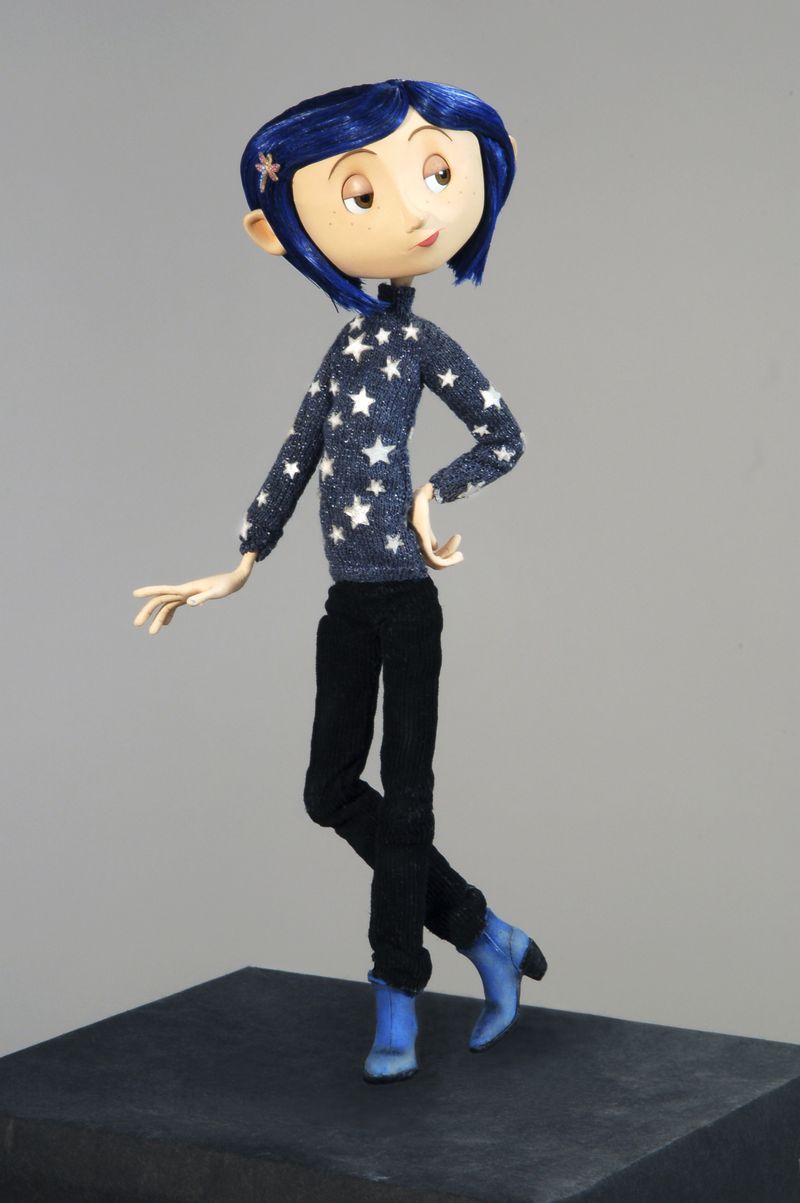 Coraline puppet wearing a sweater hand-knit on miniature knitting needles
Coraline puppet wearing a sweater hand-knit on miniature knitting needles
There are a number of knitted garments worn by characters in the film: Coraline’s gloves and star sweater, Bobinsky’s undershirt, etc. Were these knit by hand? Can you describe the process of knitting such small items?
Bobinsky’s undershirt was made from a carefully chosen knitted fabric and has a foam under-structure. Coraline’s gloves and the base shape for her blue star sweater were knitted flat by a miniature knitter on tiny needles, then the sweater was lined with latex to ensure the duplicates maintained the same shape, then hand sewn onto each puppet, as were the gloves. The stars were hand cut from several selected layers of fabric bonded together to create the right level of iridescence and added afterward. The sweater had its own ‘map’ for the stars, again to maintain consistency among the duplicates.
Did you create footwear for each character? I’m thinking in particular of the monkey slippers worn by Coraline’s father and Coraline’s blue boots.
Yes, each character had their own footwear, an intrinsic part of their character profile, just like people and their shoes.
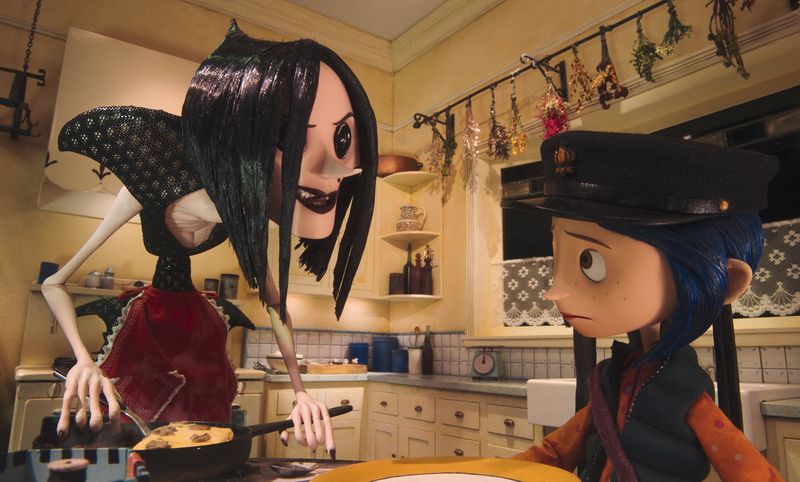 The Other Mother serves Coraline breakfast
The Other Mother serves Coraline breakfast
The Other Mother’s costume evolves as her true personality becomes apparent. Can you describe your inspiration in designing this particular costume? It reminded me of an Alexander McQueen suit!
Very flattering that you compare the evolution of Other Mother’s costume to an Alexander McQueen suit! I’ve admired his work since his outset. I live in London and lament the loss of him as a person, living and creating in London. We’ll all miss his huge talent to reinvent materials, engineer and design fantastically innovative fashion. For the costume, we took inspiration from the patterns and structure of tropical beetle shells, wings and undercarriages and very sculpted graphic print, high end designer dresses, merging the two. There are approximately 40 panels in the final costume as she unfurls.
 Design boards for the Other Mother
Design boards for the Other Mother
Coraline is based on a 2002 novel by Neil Gaiman. Did you rely on descriptions of clothing in the book to inform your designs? What other resources (books, images, etc.) contributed to your design process?
The screenplay was written by Henry Selick, adapted from Neil Gaiman’s book Coraline; Selick also directed the film. His [Selick’s] ideas for Coraline’s characters led the way for the costume design. The story was set in contemporary America so we looked at a lot of contemporary clothing and personality types and what they might wear as well as the original character drawings.
Was there a particular item that you loved or hated working on? If so, what was it about this particular costume that inspired such a strong reaction?
I didn’t really dislike working on any of the costumes; I enjoy the whole process too much for that. Some costumes have more prestige surrounding them such as the first costume on a production or for the main character, like Coraline’s raincoat. These tend to go through many stages and take longer to satisfy everyone’s concerns for that character, but when it’s nailed it’s really exhilarating.


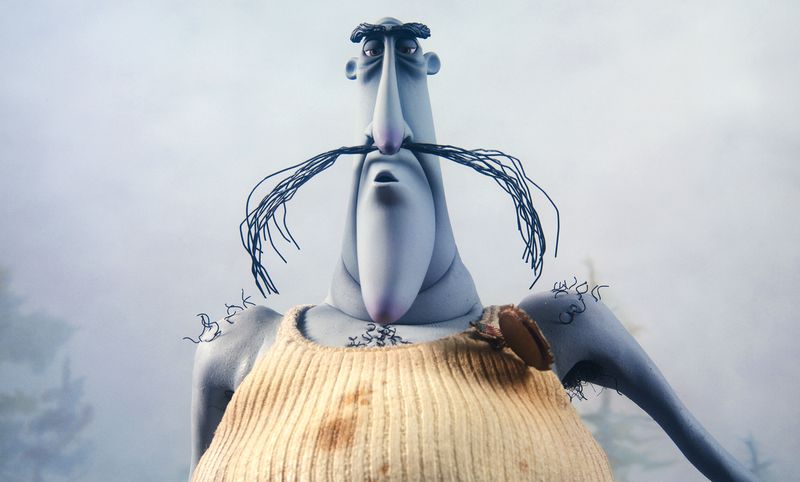


What a fascinating interview! Because I too sometimes work in miniature (but in paper), the details of how such costumes were created was especially interesting.
What a fascinating interview! Loved Caroline and the meticulous detail evident in every frame, but I had no idea how laborious was creating the costumes.
Absolutely love this! Deborah Cook Is an amazing artist and really brought the mood to each scene. Who doesn’t want a Coraline with the star sweater or a pair of gloves to add to their collection??
I’m going to post these on my Instagram “@classydarktoys” where me and my 5k followers post our collections of Coraline, James and the Giant Peach, and anything Tim Burton. Come check it out if you’re a fan of Stop Motion or Coraline in general. I will of course tag Deborah Cook in the photos as well as Liaka because I do not condone theft of photos without giving credit to the artist, beautiful pieces came from this movie. I wish ewe could buy more merchandise to go on our figures like Coralines hat!